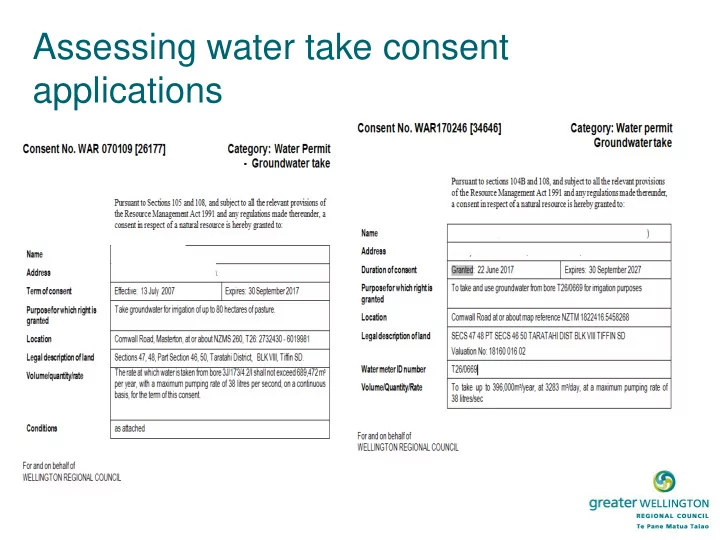

Assessing water take consent applications
Allocating water • New users vs. existing users
Water allocation calculator - RFP Groundwater allocation Surface water allocation Raw background data
Water allocation calculator - PNRP Groundwater totals and raw background data Surface water totals and raw data
Existing users renewing their consents • the plan allows for allocation to be granted provided it does not exceed whichever is greater of • (i) the maximum amount allocated by resource consents at the date the consent application is lodged, or • (ii) the allocation amounts in Tables 7.3-7.5
Schedule Q: Reasonable and efficient use criteria Irrigation • field validated model that reliably predicts annual irrigation volume within accuracy of 15% • Must meet criteria of irrigation application efficiency of 80% and demand conditions that occur in nine out of ten years Group or community water supplies • Water management plan that addresses a) the reasonable demand for water taking into account size (# of people) and different sectors that will use water b) amount of water required for health needs of people and how water will be managed under restrictions c) the effectiveness and efficiency of the distribution network Water Races • Information that identifies water race sections where efficiency can be improved plus include a timetable of investigations for improvement options Other Uses • Assessment of reasonable and efficient use, calculated in accordance with good management practices for efficient use of water or demonstrate that water is not being wasted
Field Validated Model - IrriCalc
Data
Example of Schedule Q in use • Consent processed 2007: • Consent renewed 2017
Policy links to Schedule Q • Policy P118: Reasonable and efficient use • Policy P119: Unused water
Irrigation Efficiency Surface Water intake Centre Pivot - Efficiency range 85 - 94 % Travelling Gun – Efficiency range 60 – 75 % Groundwater take – headworks and bore
Schedule P: Classifying & managing groundwater and surface water connectivity • Four different ‘categories’ of water Surface Water (SW) Category A groundwater Category B groundwater – weekly average rate of take of > 5L/sec and Groundwater directly connected to SW represents a flow depletion from local surface waters of >60% of the rate of take or >10L/sec Category B groundwater – balance of above and any take with weekly average Groundwater not directly connected to abstraction <5L/sec SW Category C groundwater
Classifying Categories
Policy P115 – Authorising takes below minimum flows and lake levels The take and use of water may be authorised below minimum flows or lake levels established in whaitua chapters of the Plan (chapters 7-11) for: (a) the health needs of people as part of group drinking water supply or community drinking water supply, and (b) the water used by industry from a community drinking water supply for a period of seven years from the date of public notification of the Proposed Natural Resources Plan (31.07.2015), and (c) permanent horticultural or viticultural root crops (excluding pasture species, animal fodder crops and maize) for the sole purpose of avoiding their death provided: (i) the water shall only be available five days (120 hours) after minimum flow cessation take restrictions are imposed and where no practical alternative sources of water are available or accessible, and (ii) the amount of water needed shall be determined following consideration of the extent and type of crop(s) and the risk of crop death in drought situations, and (d) category A groundwater which shall be required to reduce the take by 50% of the amount consented above minimum flows, (e) category B groundwater (directly connected), category B groundwater (not directly connected) and category C groundwater. Typical condition to reflect (d) When the flow in the Waingawa River at Kaituna monitoring site falls below 1900 litres/second the consent holder shall: • Restrict the abstraction to a cumulative total of 12 hours/day; and • Not take water between 8am and 5pm (in order to minimise evapotranspiration losses); unless otherwise agreed to the satisfaction of the Manager, Environmental Regulation.
Anomalies • P115/Rule R.R1: the take or use below min flow – no exceptions provided for e.g. ‘back flow’ consents and water races • Rule R.R1: Industry water not supplied below minimum flow after 7 years • Surface water takes vs. Category A groundwater takes – policy framework gives no discretion for restriction levels
Group or community water supplies – Schedule Q • Difficult to put a number on the health needs of people
Conclusions • pNRP provides more tools for water to be ‘clawed back’ though attrition then the RFP • pNRP allows us to more accurately categorise groundwater takes and their connection to surface water and thereby restrict them accordingly (but could still provide further discretion) where as the RFP was silent on this issue
Recommend
More recommend